 Gilman Studio On-Line Lessons
Gilman Studio On-Line Lessons
Yang Style Long Form
Tai Chi Chuan
This Lesson Contains:
Movement # 32- Turn and Chop Opponent With Fist
This is a big, rather complicated movement. There are a lot of application possibilities contained within this movement. Study it carefully and you will learn a lot of Tai Chi basics.
I want to remind you once again that any movement has dozens of possible applications. What you imagine is happening in a movement will affect the way the movement is performed. For this course, I have chosen an application that I think is easy to understand and illustrates some important points. When I practice Tai Chi for myself, I might do this particular application or I might do something else, which would subtly affect its outward appearance. The application and the outward appearance of a movement is not nearly as important as understanding the basic principles of Tai Chi and focusing on the energy moving within the body. There is no one right way of how to do the form, only correct understanding of the Tai Chi Classics.
My partner for this and the next few movements is John Considine, also known as Barru, one of his many movie roles. His dramatic nature will be witnessed in these movements.
The opponent approaches from the rear. I turn, neutralize an incoming strike, strike with a back fist, and follow up with a palm strike.
Note: The first picture is of me in the final posture of Fan Through the Back with John behind me. It looks silly to me, but you must realize that not all movements of this form follow the preceding movement. In order to keep the flow of energy from one movement to another, sometimes I design an application that sort of fits, to help the student do the movement smoothly and with some purpose. This movement works just as well if I am facing a person and he strikes out.
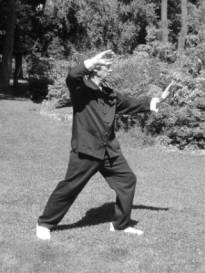
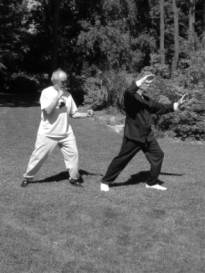 The opponent is behind me. I am facing west.
The opponent is behind me. I am facing west.

 I am in the process of turning to deal with the threat. This is the half way point in my turning to join with the opponent.
I am in the process of turning to deal with the threat. This is the half way point in my turning to join with the opponent.
The weight is shifting back onto the right foot as the torso turns to face north. The left foot is turned until the toe faces north. Be careful not to stand up when making this turn.
In this instance the body turning and the shifting back of the weight onto the right foot happens together. Most of the time, the weight is shifted back and then the torso turns (e.g. Fist Under Elbow and Single Whip).
The arms move with the body. The right elbow is dropping slightly to guard the vulnerable under arm area. The left arm is rising slightly. The palms face outward.
Focus the energy on the Dan Tien (center).
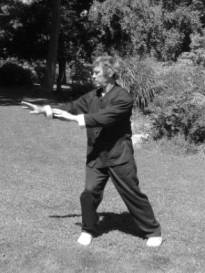
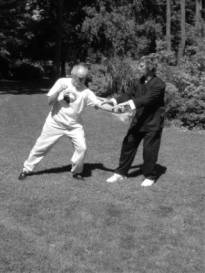 The turn is complete. This is the point where I join with the incoming energy and neutralize it to the left, closing John up and pulling him out of his root. There are two torso activities going on here.
The turn is complete. This is the point where I join with the incoming energy and neutralize it to the left, closing John up and pulling him out of his root. There are two torso activities going on here.
The weight is now totally on the right foot. The torso has turned slightly further then north with the arms on either side of the body at lower chest level. The arms do not cross the body. It is like Commencement with the torso turned to the right. The palms face downward. This is the join phase.
The neutralize happens by shifting the weight onto the left foot and opening the right hip so the right toe faces the opponent (east). The arms stay in the same relative position and pull back with the body shift.
Focus on the palms for joining, sticking, and leading.
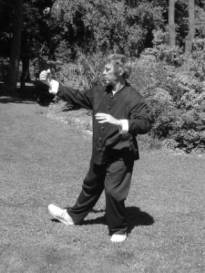
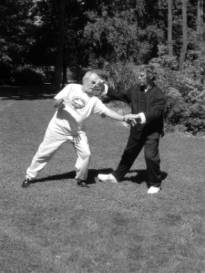 As John tries to regain balance, I follow his retreat with a right back fist strike.
As John tries to regain balance, I follow his retreat with a right back fist strike.
Step out with the right foot just to the right of east. Don’t put any weight on this foot yet. Actually, sink the root even deeper into the left foot as you deliver the back fist.
As the right foot steps out, the right arm makes a circle by pivoting at the elbow. The right hand forms a fist at the top of the arc, which is level with your nose. The left hand remains in the same position.
The left hand holds opponent’s left wrist when the back fist is delivered so the strike will penetrate. It also keeps the opponent off balance as he tries to escape.
Focus on the right fist for strike and the left hand for pulling.
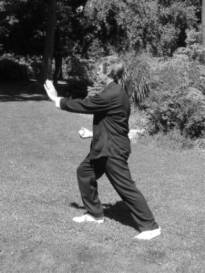
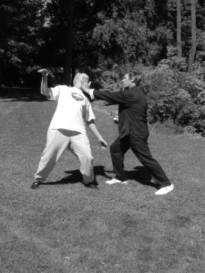 The back fist is followed by a left palm strike or push.
The back fist is followed by a left palm strike or push.
Shift the weight onto the right foot until the knee just covers the toe. At the same time, turn the torso until the nose points to the knee. The left hip rotates inward, pulling in the left toe until it is about 45-degrees left of the right foot direction. Your body now faces slightly to the right of east.
The right fist continues its arc and ends up on the right side of the waist with the fingers facing upward. The left palm has extended outward to end up on the left side of the center of the chest. The two arms move as one unit, the pulling down and in of the right fist and the moving out of the left palm.
Focus on the left palm for strike or push.
 The final position as seen from the front.
The final position as seen from the front.
Some of the important principles contained in this movement:
1) The armpit is a very vulnerable spot. Always keep it guarded. That is why the right elbow dropped at the beginning of the movement.
2) Always seek to follow the direction of the incoming energy and help it go further then it wants to go to break the root of the opponent. Also, try to keep the opponent closed up by crossing one arm in front of his body. All this was accomplished when my palms joined John’s strike and led it to the left.
3) When delivering a strike, pulling some part of the opponent in the other direction will increase the force.
